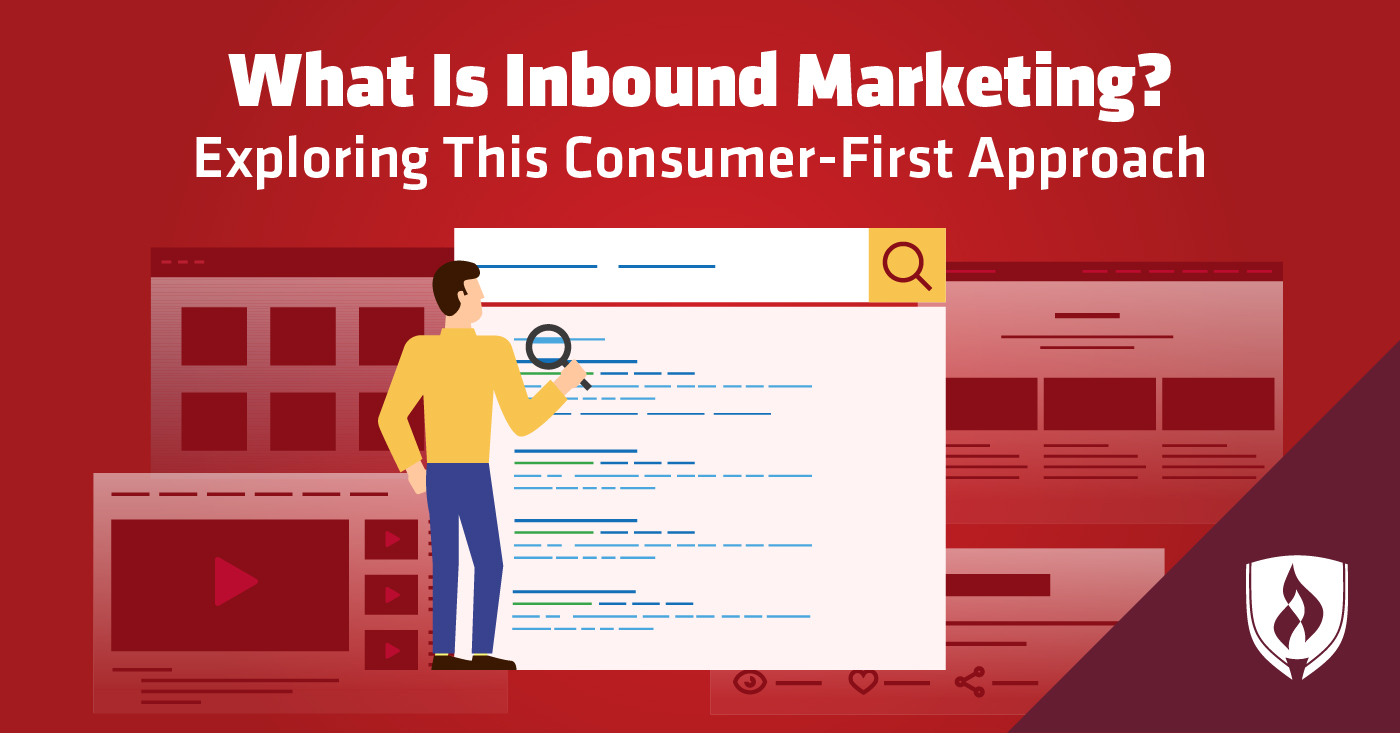
Inbound marketing is the talk of the town in the business world. Every business-related publication from Forbes to the Wall Street Journal seems to have turned their attention to this relatively new marketing method designed for the digital age.
All the fuss probably has you wondering what inbound marketing is. Is it really that big of a deal? Or is it more of a passing fad? You have a growing interest in learning about all things marketing, but you don’t want to give inbound marketing too much of your attention if it’s not long for this world.
Fortunately, inbound marketing is more than just the latest trend. In fact, it’s already a well-established approach to digital marketing with an entire ecosystem of marketing professionals sharing their advice for this growing niche—and it doesn’t appear to be going away any time soon.
So let’s get right to it—in this article we’ll explain what inbound marketing is, how it works and why it matters for digital marketing professionals.
What is inbound marketing?
Many people assume marketers are all similar to used car salesmen: people who actively pressure others to use their products with over-the-top pitches and very direct tactics. Inbound marketing, however, takes a much gentler approach. Rather than interrupting people with annoying ads or unwanted cold calls, inbound marketing is a method that draws customers in by meeting them where they’re at and providing useful information.
So what does that look like? A power tool company might create how-to guides for common home repairs. While not everyone who views those guides may be in the market for new tools, some will be—and seeing a helpful video that highlights how easy these tools make a project can help push someone closer to buying.
“Inbound marketing is a business strategy that attracts clients by creating valuable, niche-specific content and a fantastic user experience,” says Raul Mercado, owner at Mercado Wix Design. “The content solves problems the client is already looking for, and the user experience helps form deeper connections.”
Content—everything from blog posts to infographics to explainer videos—is at the center of most inbound marketing strategies. This content offers high value to potential customers. Its goal is to draw them in by answering questions they were already searching for. This is why many companies have a corporate blog, a growing social media presence and sometimes even podcasts or video blogs.
Blog posts alone don’t make for an inbound marketing strategy, however. “As an inbound marketer, it is important to keep the customer engaged by creating content that specifically addresses solutions to their problems,” says inbound marketing manager Shoshi Goldstein. Inbound marketers must pair value-driven content with a strategic sales funnel that “attracts the right type of people, those who are going to convert.”
The history of inbound marketing
While inbound marketing has certainly gained a lot of steam in recent years, here’s a little secret: Much of it is really nothing new. Ever hear of a Michelin Star restaurant? The guidebook identifying all of these far-flung (and excellent) eateries was originally created in 1900 in order to get people traveling, and consequently, buying more tires. Your grandma’s cookbook? There’s a good chance it was created by a food producer in order to highlight additional uses for their products—who knew cream of mushroom soup could be the base for nearly anything?
Of course, these clever approaches weren’t exactly common—so what gave this approach a jump-start? The answer goes back to the advancing digital world, which changed the way brands interact with consumers.
Inbound marketing rose out of a “seismic shift in the digital landscape,” according to Greg Bullock, marketing manager at TheraSpecs. With the rise of the internet, growth of social media sites and device usage increasing by the day, businesses were on the lookout for better ways to connect with consumers who’ve become inundated with advertisements.
That’s where inbound marketing comes in. “Inbound marketing became all the rage after the term was coined by HubSpot in 2005,” Bullock says. HubSpot, a customer relationship management (CRM) software company, is still at the forefront of the expanding inbound marketing movement, sharing resources like their popular “flywheel” philosophy of attracting, engaging and delighting consumers to earn their business.
At the same time, search engines were constantly refining their algorithms to show users websites that provided the answers they’re looking for. “The ability to use a search engine to find what you wanted gave consumers real purchasing power for the first time,” Mercado says.
This marriage of search and content gave steady rise to inbound marketing. “The instant access to information online all fundamentally changed consumer behavior by giving greater control over how and when they engaged with businesses,” Bullock says. “This created opportunities to reach these potential customers beyond the traditional forms of marketing.”
In short? The internet made it very easy to find the topics or questions people were searching for—and smart marketers saw an opportunity to position their brands as an authority by creating content that fits these searchers’ needs.
The importance of inbound marketing
Inbound marketing represents a shift in the way consumers and businesses interact with each other. Consumers no longer want to be constantly sold to; they want to do business with brands they like and trust. Inbound marketing is one way to build that foundation of trust with consumers.
“Brands have to provide value beyond just their product or service in order to be relevant at each stage of the customer journey,” Bullock says. Companies build rapport with consumers by creating content that’s informative and entertaining, that promotes their causes and values, and that engages consumers on a human level in a way that traditional marketing ads can’t match.
In addition to building trust, inbound marketing lets consumers know that a particular brand exists in the first place. This phase of the sales funnel is called awareness, and it’s vitally important for businesses who want to stand out in a competitive market.
Google® reports that 51 percent of smartphone users have discovered a new company or product through a search on their phones.1 Inbound marketing makes the most of these search-engine users, as well as social media channels, to promote awareness of their brand in a way that can have a big payoff. One study by the Journal of Consumer Research found that “repeated exposure to a brand will lead to an increased likelihood of selecting that brand” by consumers making a purchase.2
With inbound marketing both boosting sales and building trust with consumers, it’s not hard to see the importance of this marketing model.
Inbound marketing tactics
Inbound marketing is a big-picture methodology for attracting the right consumers. It may sound simple enough, but there are many specific actions that take place to bring inbound marketing to life.
“Tactics for successful inbound marketing include SEO, content creation, social media, branding and more,” Goldstein says. These are just a few of the tactics that inbound marketers use to connect with consumers on a daily basis:
- Search engine optimization (SEO) is the strategic use of keywords to get a certain piece of content to “rank” as high as possible on the results page of a search engine.
- Content marketing is the creation of anything that shares information, like blog posts, podcasts, videos and infographics. Inbound marketers strategically plan content that meets their consumers’ needs and is presented in a way that’s consistent with their brand.
- Email marketing is used to reach out to consumers directly in their inbox, like when companies send emails offering coupons, announcing sales or sharing other special perks. This approach is often used in concert with content marketing—think of guides and information that are only accessible if you provide an email address first.
These tactics have been tried and true for more than a decade of inbound marketing, but new forms of this consumer-centered marketing strategy are on the horizon. Bullock sees enhanced personalization as an upcoming tactic that will allow brands to connect with consumers on a deeper level than ever, while Goldstein believes that artificial intelligence, automation and voice search will soon come into play.
Regardless of which tactics they use, inbound marketers must always come back to a focus on growing a long-term relationship with their customers. “There are no shortcuts to inbound marketing,” Mercado says.
A marketing career worth considering
Now that you’re aware of the value inbound marketing brings to companies and consumers alike, you’ve moved on from asking “What is inbound marketing?” to “Could inbound marketing be the career for me?”
The first step to working in inbound marketing is to earn a related degree. Find out whether you’re a good fit for a marketing degree with our article “Should I Be a Marketing Major? Everything You Need to Decide.”
1Google, Think With Google, Being there in micro-moments, especially on mobile [accessed August 2019] https://www.thinkwithgoogle.com/marketing-resources/micro-moments/being-there-micromoments-especially-mobile/
2ScienceDaily, University of Chicago Press Journals, Subconscious Encounters: How Brand Exposure Affects Your Choices [accessed August 2019] https://www.sciencedaily.com/releases/2008/10/081014111202.htm
Google is a registered trademark of Google, LLC.




